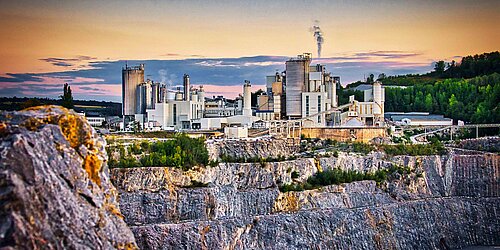Raw materials make carbon emissions unavoidable in lime production
Lime is an indispensable for the modern age, being an essential material for use in construction and a basic material for many another sectors. Lime is not only needed for manufacturing iron and glass as well as chemical and medical products but is also important in agriculture and the food industry. Other uses for lime include drinking water purification, waste water treatment and industrial flue gas scrubbing, as well as residential housing construction and road building. Lime is an ever-present and vital resource that enables our day-to-day lives.
Currently, around 6.4 million tonnes of lime are produced every year in Germany. Producing one tonne of lime causes the emission of about 750 kg of CO2 into the atmosphere. In 2022, the production of lime for industrial and construction resulted in emissions totalling roughly 6.7 million tonnes of CO2, which is equivalent to around 4 percent of industrial and energy emissions in Germany. Most of these emissions, roughly two thirds, result from the calcination of the raw material – essential for both the process and the material itself. During the calcination process, chemical reactions occur at high temperatures of around 900 °C that expel carbon dioxide from the limestone. These emissions result from the raw material itself and are unavoidable. The other third of the emissions results from the high temperatures needed and therefore stems from the combustion of fuel to produce energy.
Approaches to climate-neutral production
When compared with figures for other sectors, total carbon emissions from the lime industry are comparatively low. Even so, cutting these annual emissions of several million tonnes of CO2 also helps Germany to achieve its climate neutrality targets. To do so, approaches are concentrating on the use of alternative fuels and green electricity as key technologies for climate-neutral lime production. Due to the significant proportion of emissions caused by the raw material itself during manufacturing, there is a strong focus on separation technologies followed by storage or usage of the CO2 (CCU/CCS technologies).
Current research in the industry is addressing what is known as the ‘carbonation’ of lime products. As a result of its chemical makeup, lime has the capability to bind CO2, depending on the application. This process is referred to as carbonation. Research has identified eight industrial processes in which this carbonation can occur – which include the commonest use cases for lime, namely iron or steel production and flue gas scrubbing. This offers a way to bind the CO2 emitted due to the nature of the raw material back into the actual product.
The biggest challenge for the lime industry
Reducing the unavoidable, raw material-based emissions presents the lime industry with a unique challenge. Even if the energy-intensive calcination process is fully electrified, other technologies need to be implemented for the separation of the CO2 to achieve climate-neutral lime production.
While CCUS technologies could be deployed for this purpose, they have met with strong resistance in relation to the phasing out of fossil fuels in recent years. However, they are starting to win broader acceptance in the context of climate change mitigation. That said, a set of policy frameworks and legislation that defines a clear set of terminology together with limit values continues to be lacking. Preferably, CCUS would be deployed as an interim technology for unavoidable emissions and should not work to delay fossil fuel exit strategies.
In addition, the process will require a corresponding infrastructure in the near future, to facilitate the transportation of the captured CO2 to storage facilities or for downstream use in other industrial processes – such as the basic chemicals industry or the food industry.
Regulatory frameworks for successful reductions in carbon emissions
Rolling out a new technology is typically associated with large upfront investment costs. To be able to plan for the long term, companies therefore need to be assured that their investments are protected. An appropriate legal basis for carbon storage also needs to be established. Social acceptance also has an important role to play.
Examples from practice

RETAKE
Options for capturing atmospheric carbon by raising alkalinity
